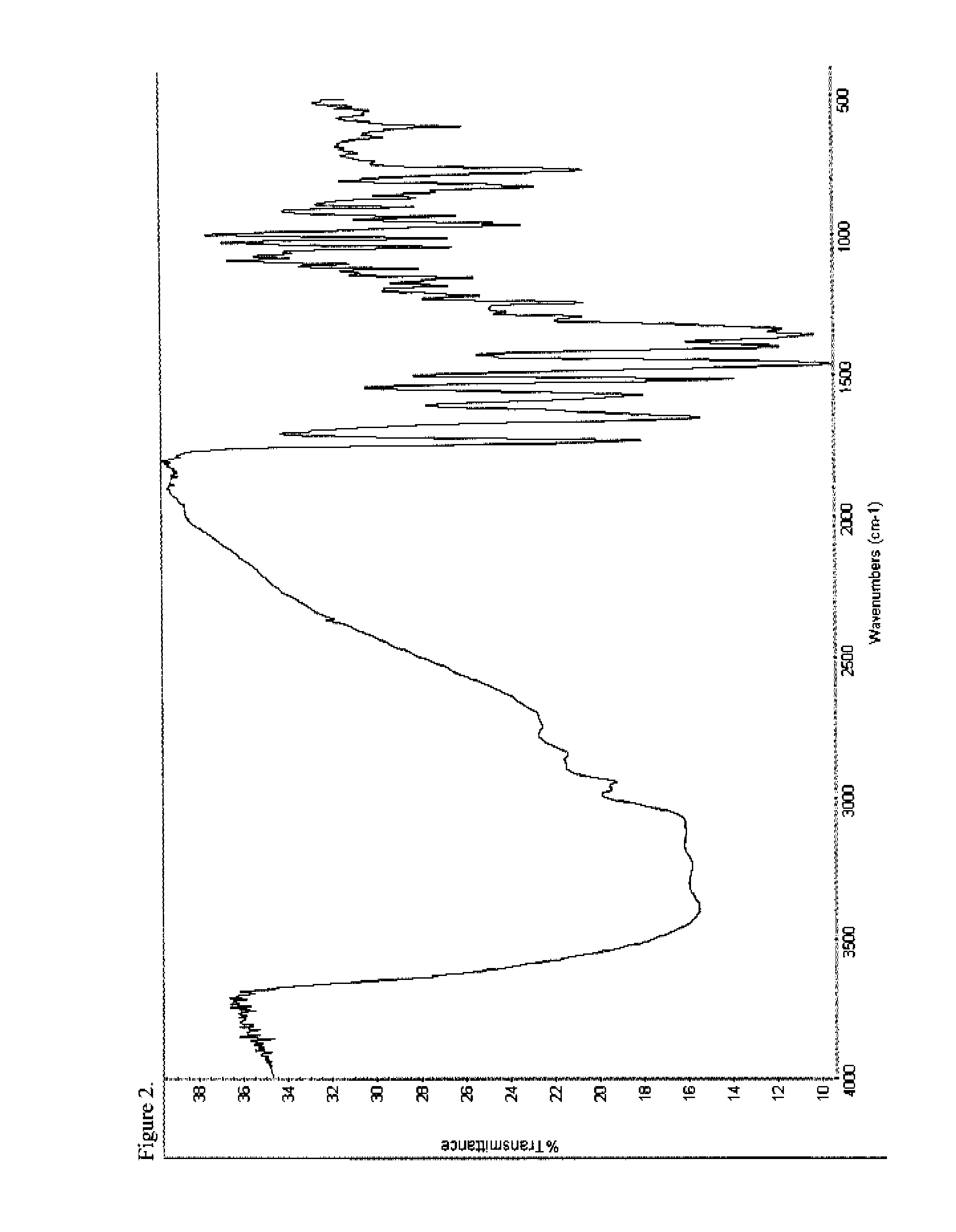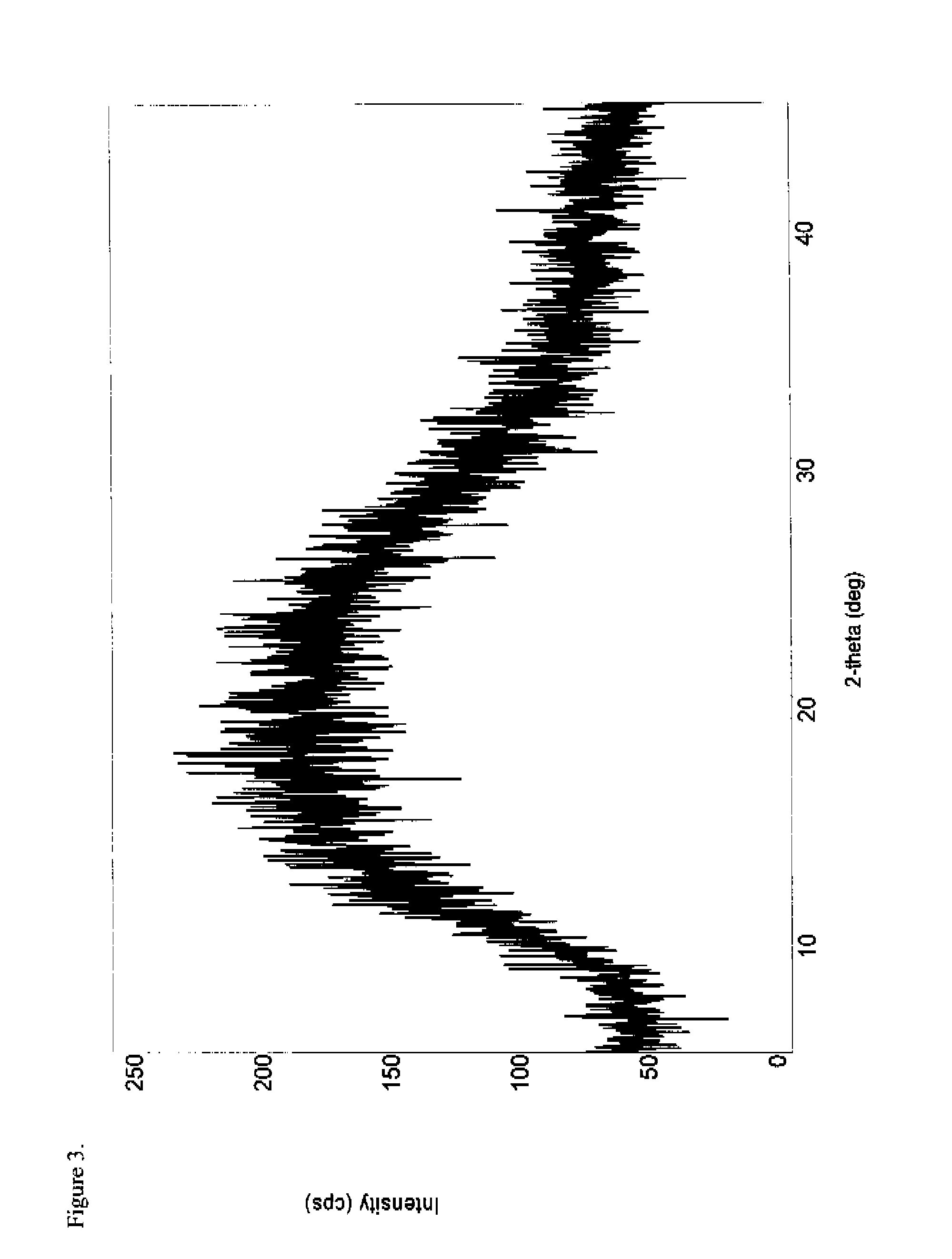Opioid Salts with Release Properties and Characteristics Useful for Abuse Deterrent Drug Product Formulations
a technology of oxymorphone and levorphanol, which is applied in the field of salts of oxymorphone, codeine, levorphanol and naltrexone, can solve the problems of reducing the abuse of drug products by administrative or bureaucratic means, which are generally ineffective, costly, and provide an undue hardship and burden on the citizenry of the nation, and achieves the effect of robust and stable drug product formulations
- Summary
- Abstract
- Description
- Claims
- Application Information
AI Technical Summary
Benefits of technology
Problems solved by technology
Method used
Image
Examples
example 1
Preparation of Amorphous Oxymorphone Pamoate (2:1)
[0183]To a 250 mL 3-neck round-bottom flask equipped with a mechanical stirrer, thermowell, nitrogen inlet and addition funnel was charged disodium pamoate (1.90 g, 4.22 mmol) and water (54 g). The pH was adjusted to about 9 with 1 drop of 1N sodium hydroxide (90 mg) and stirred under nitrogen. A solution of oxymorphone hydrochloride (3.0 g, 8.88 mmol) in water (33 g) was prepared by charging to a 100 mL beaker and stirring with a magnetic stir bar. The oxymorphone hydrochloride solution was added dropwise to the disodium pamoate solution via addition funnel over 5 minutes. The resulting off-white slurry was stirred for 5 hours at ambient temperature followed by the solids collected by filtration through a medium fritted filter and thereupon washed with four 50 mL portions of water. The product was dried overnight under reduced pressure to provide 3.59 g (86% yield) of an off-white solid (Karl Fischer, or KF, 1.8% H2O) which was anal...
example 2
Preparation of Polymorphic Oxymorphone Pamoate (2:1)
[0184]To a 100 mL round-bottom flask equipped with a magnetic stir bar, thermowell and nitrogen inlet was charged amorphous oxymorphone pamoate (1.0 g, 1.01 mmol) and a 98:2 ethanol-water solution (43.5 g). The combined solution was heated to 76° C. under nitrogen for 5-6 hours and subsequently cooled in an ice bath to about 10° C. The solids were collected by filtration through a medium fritted filter and washed with a very small portion of ethanol. The product was dried overnight under reduced pressure to provide 0.87 g (87% yield) of an off-white solid (KF 7.41% H2O) which was characterized by DSC (FIG. 5), FTIR (FIG. 6), PXRD (FIG. 7), and 1H-NMR (FIG. 8). The 1H-NMR spectrum was consistent with a compound having a 2:1 ratio of oxymorphone to pamoate and the PXRD diffractogram indicated the salt was crystalline.
example 3
Preparation of Oxymorphone Xinafoate
[0185]To a 100 mL three-neck round bottom flask equipped with a mechanical stirrer, reflux condenser, thermowell and nitrogen inlet was charged BON (beta-oxy-naphthoic acid, also known as 2-hydroxyl-3-carboxy naphthalene (1.63 g, 8.67 mmol) and water (23 g). Sodium hydroxide (ACS grade, 346.8 mg, 8.67 mmol) was added and the solution heated to 50° C. under nitrogen until all the solids dissolved. The sodium xinafoate solution was then cooled to ambient temperature.
[0186]A solution of oxymorphone hydrochloride (2.93 g, 8.67 mmol) in water (31 g) was prepared by charging to a 100 mL beaker and stirring with a magnetic stir bar. The oxymorphone hydrochloride solution was then added dropwise to the sodium xinafoate solution prepared above via addition funnel over 10 minutes. A sticky solid formed and the reaction mixture was heated to 50° C. for 30 minutes which formed an oily layer. The solution was subsequently cooled to ambient temperature and stir...
PUM
| Property | Measurement | Unit |
|---|---|---|
| pH | aaaaa | aaaaa |
| pH | aaaaa | aaaaa |
| solubility | aaaaa | aaaaa |
Abstract
Description
Claims
Application Information
 Login to View More
Login to View More - R&D
- Intellectual Property
- Life Sciences
- Materials
- Tech Scout
- Unparalleled Data Quality
- Higher Quality Content
- 60% Fewer Hallucinations
Browse by: Latest US Patents, China's latest patents, Technical Efficacy Thesaurus, Application Domain, Technology Topic, Popular Technical Reports.
© 2025 PatSnap. All rights reserved.Legal|Privacy policy|Modern Slavery Act Transparency Statement|Sitemap|About US| Contact US: help@patsnap.com



